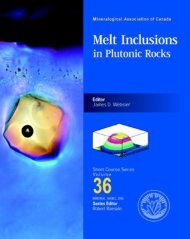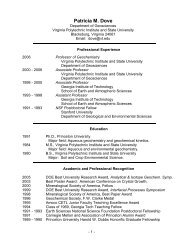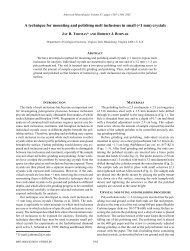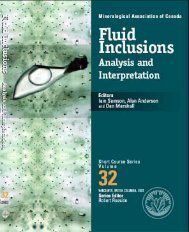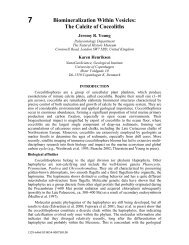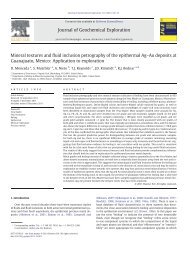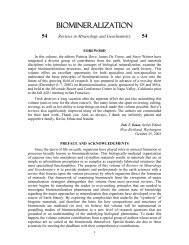Laser Ablation–ICP–MS in the Earth Sciences ... - Virginia Tech
Laser Ablation–ICP–MS in the Earth Sciences ... - Virginia Tech
Laser Ablation–ICP–MS in the Earth Sciences ... - Virginia Tech
Create successful ePaper yourself
Turn your PDF publications into a flip-book with our unique Google optimized e-Paper software.
S.R. MUTCHLER, L. FEDELE & R.J. BODNAR<br />
APPENDIX A5: ANALYSIS MANAGEMENT SYSTEM (AMS) FOR REDUCTION OF LASER<br />
ABLATION ICP–MS DATA<br />
S.R. Mutchler, L. Fedele and R.J. Bodnar<br />
Department of Geosciences<br />
Virg<strong>in</strong>ia <strong>Tech</strong><br />
Blacksburg, VA 24061<br />
E-mail: rjb@vt.edu<br />
INTRODUCTION<br />
This paper describes <strong>the</strong> Analysis Management<br />
System (AMS) software that has recently been<br />
developed to facilitate <strong>the</strong> reduction of data from<br />
laser ablation <strong>in</strong>ductively coupled plasma–mass<br />
spectrometric (LA–ICP–MS) analysis of various<br />
materials. While <strong>the</strong> AMS software is applicable to<br />
analysis of any material, it was developed to<br />
address analytical and data reduction issues that are<br />
unique to <strong>the</strong> analysis of materials that are small<br />
(result<strong>in</strong>g <strong>in</strong> a short-lived signal) and/or<br />
heterogeneous at <strong>the</strong> scale (both spatial and<br />
temporal) of <strong>the</strong> analysis. Specifically, <strong>the</strong> AMS<br />
software is designed and optimized for reduction of<br />
data from fluid and melt <strong>in</strong>clusions <strong>in</strong> geologic<br />
samples (Roedder 1984).<br />
In develop<strong>in</strong>g <strong>the</strong> AMS software, our goals<br />
were to develop an easy to use tool for reduction of<br />
LA–ICP–MS data from fluid and melt <strong>in</strong>clusions.<br />
To accomplish this we have automated many of <strong>the</strong><br />
time-consum<strong>in</strong>g steps commonly <strong>in</strong>volved <strong>in</strong> LA–<br />
ICP–MS data reduction, such as normalization to<br />
100% oxides. In addition, <strong>the</strong> AMS can provide<br />
more accurate and precise results by m<strong>in</strong>imiz<strong>in</strong>g<br />
systematic errors, by allow<strong>in</strong>g <strong>the</strong> use of multiple<br />
standards, and by <strong>in</strong>corporat<strong>in</strong>g an improved drift<br />
correction methodology.<br />
The AMS software has <strong>the</strong> option to provide<br />
output as a s<strong>in</strong>gle file that conta<strong>in</strong>s <strong>the</strong> ICP–MS<br />
data, <strong>the</strong> various options for data reduction, and <strong>the</strong><br />
results, and is thus highly transportable. Moreover,<br />
AMS is a stand-alone software package that<br />
elim<strong>in</strong>ates <strong>the</strong> need to purchase and learn to use<br />
commercial software. AMS software is written <strong>in</strong><br />
Java and runs on Unix, Mac<strong>in</strong>tosh or W<strong>in</strong>dows<br />
platforms. AMS is compatible with data formats<br />
used by most of <strong>the</strong> major ICP–MS manufacturers<br />
(e.g., Perk<strong>in</strong> Elmer, Agilent, or any o<strong>the</strong>r <strong>in</strong>strument<br />
that has CSV-formatted output). AMS outputs <strong>the</strong><br />
results <strong>in</strong> Excel, PDF, HTML or CSV formats. It is<br />
fully configurable by <strong>in</strong>dividual users and allows<br />
edit<strong>in</strong>g of XML text files to <strong>in</strong>clude, for example,<br />
M<strong>in</strong>eralogical Association of Canada Short Course 40, Vancouver, B.C., p. 318–327.<br />
318<br />
additional standards or new mass conversion values.<br />
Importantly, <strong>the</strong> software <strong>in</strong>corporates well<br />
established algorithms for data analysis (Gun<strong>the</strong>r et<br />
al. 1998, Halter et al. 2002, He<strong>in</strong>rich et al. 2003,<br />
Longerich et al. 1996).<br />
Both <strong>the</strong> software and source code are available<br />
on <strong>the</strong> Fluids Research Laboratory website at:<br />
http://www.geochem.geos.vt.edu/fluids/laICP–MS/<br />
ams.shtml. AMS software is a community project<br />
<strong>in</strong> which <strong>in</strong>terested persons can submit requests to<br />
enhance <strong>the</strong> software or report bugs. AMS software<br />
is an Open Source application under GPL.<br />
In <strong>the</strong> follow<strong>in</strong>g sections we describe those<br />
features of <strong>the</strong> AMS software that make it unique or<br />
which represent improvement over exist<strong>in</strong>g LA–<br />
ICP–MS data reduction packages. This is<br />
accomplished by describ<strong>in</strong>g features for us<strong>in</strong>g<br />
multiple standards, apply<strong>in</strong>g drift corrections,<br />
visualiz<strong>in</strong>g fractionation patterns dur<strong>in</strong>g <strong>the</strong> analysis<br />
and f<strong>in</strong>ally by provid<strong>in</strong>g work<strong>in</strong>g examples of <strong>the</strong><br />
reduction of LA–ICP–MS data from fluid and melt<br />
<strong>in</strong>clusions.<br />
USE OF MULTIPLE STANDARDS AND<br />
DRIFT CORRECTION<br />
AMS supports <strong>the</strong> use of multiple standards for<br />
a s<strong>in</strong>gle analysis. In addition, AMS supports<br />
multiple standard runs (at different times) for each<br />
standard. A typical data reduction <strong>in</strong> AMS may<br />
<strong>in</strong>clude 6 or more spectra from 2 or more standards<br />
(e.g., NIST 610, 612, etc.) that bracket (<strong>in</strong> time) <strong>the</strong><br />
actual FI or MI analysis. The uncerta<strong>in</strong>ty <strong>in</strong><br />
standard concentrations has been shown to be one<br />
of <strong>the</strong> largest sources of error <strong>in</strong> LA–ICP–MS<br />
analysis. If multiple standards (as a multi-po<strong>in</strong>t<br />
calibration) are used dur<strong>in</strong>g <strong>the</strong> analysis of a sample<br />
with “known” element concentrations, such as <strong>the</strong><br />
G-Probe-2 microprobe standard (Potts et al. 2008),<br />
<strong>the</strong> error <strong>in</strong> element abundance is commonly less<br />
than if only a s<strong>in</strong>gle standard was used (Fig. A5-1).<br />
If <strong>the</strong> FI or MI analysis is bracketed by<br />
standard runs, AMS can also correct for any



